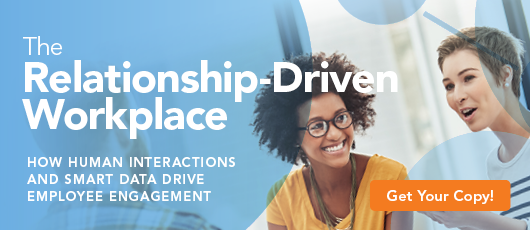6 Key Moments in the Employee Lifecycle Journey to Measure Engagement
 Relationships are key to employee engagement and performance. Strong relationships increase happiness, loyalty, and empathy, while decreasing stress.
Relationships are key to employee engagement and performance. Strong relationships increase happiness, loyalty, and empathy, while decreasing stress.
But relationships aren’t static. The ways employees feel about and interact with their coworkers, managers, teams, and customers are constantly evolving. Organizations must keep up with these shifting relationships when measuring employee engagement to ensure employees are in position to succeed.
Here are six moments in every employee's journey that are critical when measuring employee engagement.
1. Attract
Your employer brand has a huge impact on your organization’s ability to attract the right talent. It helps set you apart from other organizations competing for the same talent—and sets the stage for any future relationship. Make sure to clearly communicate around company culture and values. You want to make a good (and honest) impression before a job candidate ever sets foot inside your company.
Relationship Goal: Introduce your culture and values. Make a good impression. Help current employees understand how to advocate on your behalf.
Relationship KPIs: employee referrals, job posting metrics, volume and quality of candidates
2. Recruit
Recruiters and hiring managers should build positive relationships with any and every candidate who takes the time to apply. A little respect goes a long way—no one wants to feel ignored or left in the dark about your hiring process.
Relationship Goal: Keep the hiring process simple, transparent, and authentic. Be sure that hiring managers are well trained in communicating with and interviewing candidates.
Relationship KPIs: new hire survey results, anecdotal feedback, percent job offers accepted, time to fill
3. Onboard
Get your new hires off on the right foot with a solid onboarding process. Help them hit the ground running by setting them up for success and thinking well beyond their first day. Have a plan in place for their first 30, 60, and 90 days.
Relationship Goal: Slow and steady wins the race. Make sure new hires understand the basics before you launch them into the chaos. Connect them with others who can help answer questions throughout their onboarding process.
Relationship KPIs: onboarding survey results, completion of onboarding goals
4. Develop
The first several months of an employee’s tenure are key to their future success at the organization. Managers should continue to act as coaches and get to know each of their employees on a personal level. One-on-one conversations should be focused on development, performance, and growth.
Relationship Goal: Prioritize frequent manager-employee communication around development, goals, role, performance, etc.
Relationship KPIs: frequency and quality of one-on-one meetings, goal progress, team engagement scores, recognition stats, development opportunities completed, talent review metrics
5. Retain
Yay! Your new employee made it through their first year. But don’t get too comfortable. Once the honeymoon phase is over, employees will start itching for more. You’ve put in a lot of hard work up to this point—don’t risk losing your top performers because you think they’re happy and engaged.
Relationship Goal: Continue to listen to employees. Help managers take an individualized approach to developing and retaining key employees.
Relationship KPIs: frequency and quality of one-on-one meetings, goal progress, team engagement scores, recognition stats, development opportunities completed, talent review metrics, average tenure
6. Separate
Sometimes, it just doesn’t work out. Break-ups can hurt, but they can also serve as valuable opportunities to learn more. It’s up to you to ensure this relationship ends on a good note. The departing employee can still serve as an advocate for your organization.
Relationship Goal: Listen to feedback from exiting employees and thank them for their contributions.
Relationship KPIs: reason for leaving, turnover rate
These moments represent important checkpoints when measuring employee engagement. But how do you equip managers to handle relationships at these key moments? To answer that question and learn much more about relationships at work, get your copy of our ebook, The Relationship-Driven Workplace.



![[FREE DOWNLOAD] The Relationship-Driven Workplace: How Human Interactions & Smart Data Drive Employee Engagement](https://no-cache.hubspot.com/cta/default/99128/a36ddb13-3226-4704-9831-49706e81313e.png)



